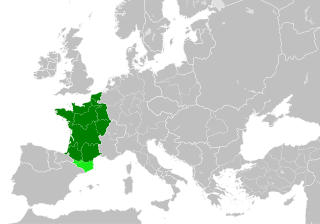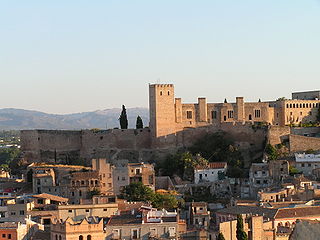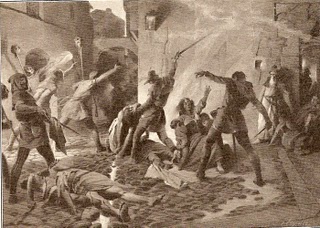
Year 1320 (MCCCXX) was a leap year starting on Tuesday of the Julian calendar.

Year 1096 (MXCVI) was a leap year starting on Tuesday of the Julian calendar.

Philip V, known as the Tall, was King of France and Navarre from 1316 to 1322. Philip engaged in a series of domestic reforms intended to improve the management of the kingdom. These reforms included the creation of an independent Court of Finances, the standardization of weights and measures, and the establishment of a single currency.

Charles IV, called the Fair in France and the Bald in Navarre, was last king of the direct line of the House of Capet, King of France and King of Navarre from 1322 to 1328. Charles was the third son of Philip IV; like his father, he was known as "the fair" or "the handsome".

The Kingdom of France in the Middle Ages was marked by the fragmentation of the Carolingian Empire and West Francia (843–987); the expansion of royal control by the House of Capet (987–1328), including their struggles with the virtually independent principalities, and the creation and extension of administrative/state control in the 13th century; and the rise of the House of Valois (1328–1589), including the protracted dynastic crisis against the House of Plantagenet and their Angevin Empire, culminating in the Hundred Years' War (1337–1453), which laid the seeds for a more centralized and expanded state in the early modern period and the creation of a sense of French identity.
The persecution of Jews has been a major event in Jewish history, prompting shifting waves of refugees and the formation of diaspora communities. As early as 605 BCE, Jews who lived in the Neo-Babylonian Empire were persecuted and deported. Antisemitism was also practiced by the governments of many different empires and the adherents of many different religions (Christianity), and it was also widespread in many different regions of the world.
History of European Jews in the Middle Ages covers Jewish history in the period from the 5th to the 15th century. During the course of this period, the Jewish population gradually started shifting from the Levant to Europe, primarily Central Europe dominated by the Holy Roman Empire or Southern Europe dominated by the Iberian kingdoms. As with Christianity, the Middle Ages were the period when Judaism became mostly insignificant in the Middle East, and a front-of-mind part of Europe.

The Rhineland massacres, also known as the German Crusade of 1096 or Gzerot Tatnó, were a series of mass murders of Jews perpetrated by mobs of French and German Christians of the People's Crusade in the year 1096, or 4856 according to the Hebrew calendar. These massacres are often seen as the first in a sequence of antisemitic events in Europe which culminated in the Holocaust.
The history of the Jews and the Crusades is part of the history of antisemitism toward Jews in the Middle Ages. The call for the First Crusade intensified the persecutions of the Jews, and they continued to be targets of Crusaders' violence and hatred throughout the Crusades.
The history of Christian thought has included concepts of both inclusivity and exclusivity from its beginnings, that have been understood and applied differently in different ages, and have led to practices of both persecution and toleration. Early Christian thought established Christian identity, defined heresy, separated itself from polytheism and Judaism and developed the theological conviction called supersessionism. In the centuries after Christianity became the official religion of Rome, some scholars say Christianity became a persecuting religion. Others say the change to Christian leadership did not cause a persecution of pagans, and that what little violence occurred was primarily directed at non-orthodox Christians.

The Aragonese Crusade (1284–1285), also known as the Crusade of Aragon, was a military venture waged by the Kingdom of France against the Crown of Aragon. Fought as an extension of the War of the Sicilian Vespers (1282–1302), the crusade was called by Pope Martin IV in retribution for Peter III of Aragon's intervention in Sicily, which had damaged the political ambitions of the papacy and France.
Antisemitism in the history of the Jews in the Middle Ages became increasingly prevalent in the Late Middle Ages. Early instances of pogroms against Jews are recorded in the context of the First Crusade. Expulsions of Jews from cities and instances of blood libel became increasingly common from the 13th to the 15th century. This trend only peaked after the end of the medieval period, and it only subsided with Jewish emancipation in the late 18th and 19th centuries.
This timeline of antisemitism chronicles events in the history of antisemitism, hostile actions or discrimination against Jews as members of a religious and/or ethnic group. It includes events in Jewish history and the history of antisemitic thought, actions which were undertaken in order to counter antisemitism or alleviate its effects, and events that affected the prevalence of antisemitism in later years. The history of antisemitism can be traced from ancient times to the present day.

The Shepherds' Crusade of 1251 was a popular crusade in northern France aimed at rescuing King Louis IX during the Seventh Crusade.
The history of the Jews in Tudela, Spain goes back well over one thousand years.

The persecution of Jews during the Black Death consisted of a series of violent mass attacks and massacres. Jewish communities were often blamed for outbreaks of the Black Death in Europe. From 1348-1351, acts of violence were committed in Toulon, Barcelona, Erfurt, Basel, Frankfurt, Strasbourg and elsewhere. The persecutions led to a large migration of Jews to Jagiellonian Poland and the Grand Duchy of Lithuania. There are very few Jewish sources on Jewish massacres during the Plague.

David Nirenberg is a medievalist and intellectual historian. He is the Director and Leon Levy Professor at the Institute for Advanced Study in Princeton, NJ. He previously taught at the University of Chicago, where he was Dean of the Divinity School, and Deborah R. and Edgar D. Jannotta Distinguished Service Professor of Medieval History and the Committee on Social Thought, as well as the former Executive Vice Provost of the University, Dean of the Social Sciences Division, and the founding Roman Family Director of the Neubauer Family Collegium for Culture and Society. He is also appointed to the Department of Romance Languages and Literatures, the Center for Middle Eastern Studies, the Joyce Z. and Jacob Greenberg Center for Jewish Studies.

The 1321 lepers' plot was an alleged conspiracy of French lepers to spread their disease by contaminating water supplies, including well water, with their powders and poisons. According to the American historian Solomon Grayzel, lepers were the most abused group of people during the Middle Ages: they were thrown out of settlements and treated as wild animals due to the widespread belief that their disease was highly contagious. However, other historians have contested such a view, pointing out that lepers often lived within communities in leper houses (leprosaria) and were supported by charitable donations.

The siege of Tortosa was a military action of the Second Crusade (1147–49) in Spain. A multinational force under the command of Count Raymond Berengar IV of Barcelona besieged the city of Tortosa, then a part of the Almoravid Emirate, for six months before the garrison surrendered.

The Massacre of 1391, also known as the pogroms of 1391, was a display of antisemitism and violence against Jews in Castile and Aragon. It was one of the Middle Ages' worst antisemitic outbreaks. Jews in the Iberian Peninsula at this time were generally disliked, and violence against them was common even until the 15th century. The year 1391, however, marked a peak of anti-Jewish violence. Facing death, many Jews converted en masse to Christianity from 1391 on.













